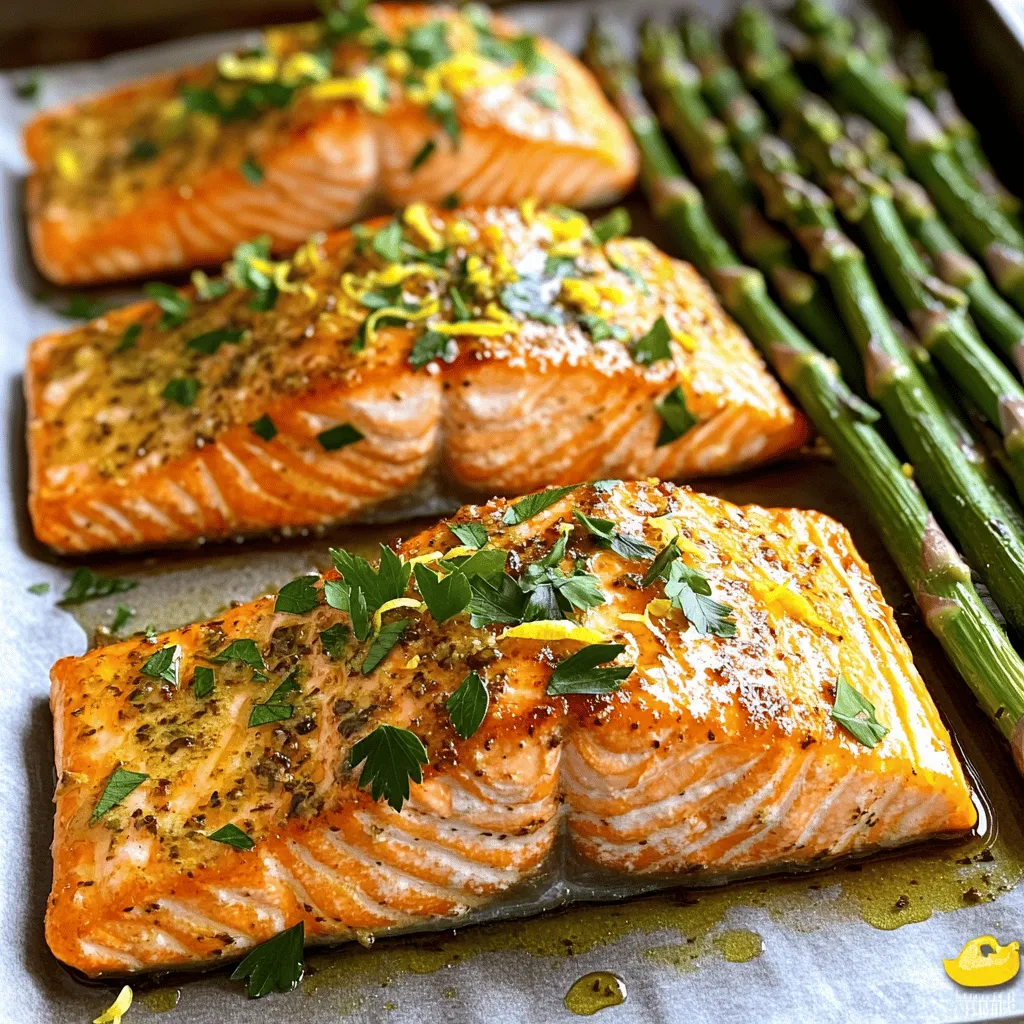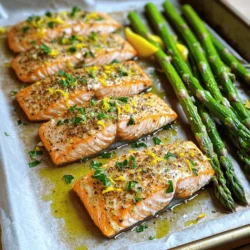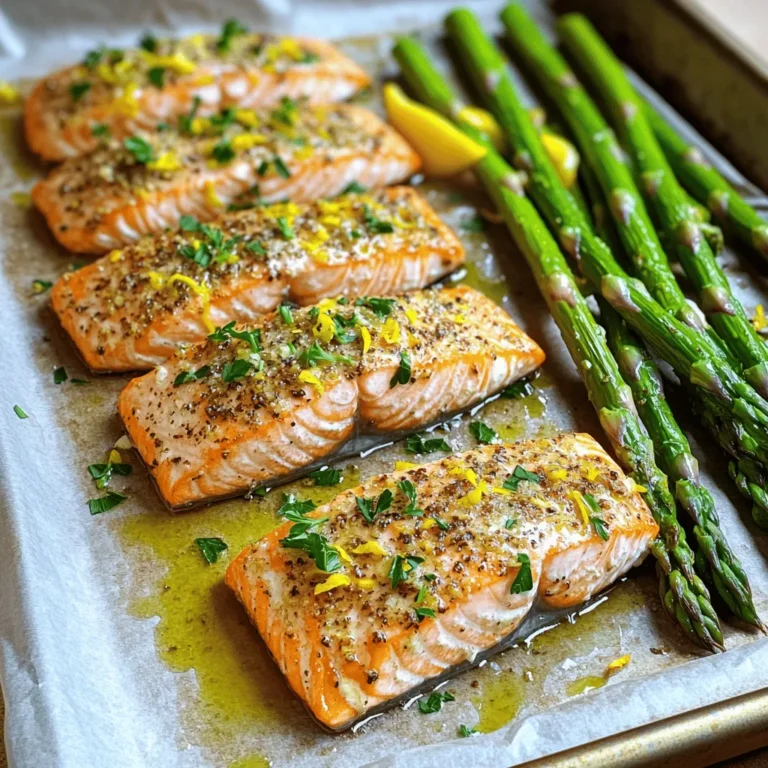Get ready to enjoy a simple and tasty meal with my Garlic Herb Salmon & Asparagus Sheet Pan Delight! This dish is packed with flavor, and it’s perfect for busy weeknights. In just one pan, you can cook salmon and veggies together, making cleanup a breeze. Follow my easy steps and tips to create a dinner that dazzles. Let’s dig into the details and get cooking!
Ingredients
List of Ingredients
To make Garlic Herb Salmon & Asparagus, you will need:
– 4 salmon fillets
– 1 bunch of fresh asparagus, trimmed
– 4 cloves garlic, minced
– 2 tablespoons olive oil
– 1 teaspoon dried oregano
– 1 teaspoon dried thyme
– 1 lemon, zested and juiced
– Salt and pepper to taste
– Fresh parsley, chopped, for garnish
Ingredient Substitutions
You can swap ingredients if needed. For salmon, try trout or chicken. Instead of olive oil, use avocado oil for a different taste. If you don’t have fresh asparagus, green beans work well too. You can use lemon juice from a bottle if you lack fresh lemons. Instead of dried herbs, fresh herbs can add great flavor. Just double the amount if you switch to fresh.
Fresh vs. Dried Herbs
When it comes to herbs, fresh and dried both have their perks. Fresh herbs offer bright, bold flavors. They work well when you add them at the end of cooking. Dried herbs are handy for their long shelf life. They pack a strong flavor punch, so use less than fresh. In this recipe, I use both types to balance taste and ease.
Step-by-Step Instructions
Preparation Steps
First, gather all your ingredients. You need four salmon fillets, one bunch of fresh asparagus, four cloves of garlic, and two tablespoons of olive oil. You also need dried oregano, dried thyme, one lemon, salt, and pepper. Finally, get some fresh parsley for garnish.
Next, preheat your oven to 400°F (200°C). This step is key for even cooking. Line a large baking sheet with parchment paper. This makes for easy cleanup later.
Now, in a small bowl, mix the minced garlic, olive oil, oregano, thyme, lemon zest, lemon juice, salt, and pepper. This mixture is your herb glaze. Stir it well until all the ingredients blend nicely.
Cooking Process
Place the salmon fillets on one side of the prepared baking sheet. Make sure to leave space between each fillet. Brush half of the garlic herb mixture over each salmon fillet. This adds flavor and moisture.
On the other side of the baking sheet, lay out the trimmed asparagus. Drizzle the rest of the garlic herb mixture over the asparagus. Sprinkle the asparagus with salt and pepper. This step enhances the taste.
Next, bake everything in the preheated oven for 15 to 20 minutes. The salmon should flake easily with a fork when done. The asparagus should be tender but still crisp.
Testing for Doneness
To check if the salmon is done, use a fork. Gently press down on the thickest part of the fillet. If it flakes easily, it is cooked. For the asparagus, it should be bright green and slightly soft but not mushy.
If the salmon is not done, return it to the oven for a few more minutes. Keep an eye on both the salmon and asparagus to avoid overcooking. Once cooked, remove everything from the oven. Let it cool for a couple of minutes before serving. Garnish with freshly chopped parsley for a pop of color.
Tips & Tricks
How to Perfect the Herb Glaze
To make the herb glaze, you need a few simple steps. First, mix minced garlic with olive oil. Then add dried oregano, thyme, lemon zest, and lemon juice. Don’t forget to season with salt and pepper. This blend gives the salmon and asparagus a fresh taste. Make sure to brush the glaze on thick. It adds flavor and moisture. If you want more zing, try adding red pepper flakes for a kick.
Recommended Cooking Equipment
You will need some basic tools to make this dish. A large baking sheet is essential for roasting. Use parchment paper for easy cleanup. A small bowl helps mix the herb glaze. A brush will let you spread the glaze evenly on the salmon. A fork is handy to test if the salmon is done. If you have a meat thermometer, use it to check the internal temperature of the salmon. It should read 145°F for perfect doneness.
Serving Suggestions
Serve the salmon and asparagus right from the oven. This dish looks great on a plate. Garnish with fresh parsley for color. Pair with a side of rice or quinoa for a complete meal. A simple green salad also works well. You can even serve it with a slice of lemon for extra zest. If you have leftovers, store them in the fridge for a tasty lunch. Enjoy this dish with family and friends for a cozy dinner.

Variations
Alternative Proteins
You can switch out salmon for other proteins. Chicken breasts work well and cook nicely. Try using shrimp for a quick option. Tofu is a great plant-based choice for a vegetarian meal. Adjust the cooking time for these proteins. Chicken may need a few extra minutes, while shrimp cooks faster.
Different Vegetables
Asparagus shines in this dish, but you can mix it up. Broccoli or green beans add a nice crunch. Bell peppers bring color and sweetness. You can even add zucchini or cherry tomatoes for extra flavor. Just ensure all vegetables are cut to similar sizes for even cooking.
Flavor Enhancements
To boost flavor, consider adding spices. Paprika or chili flakes can give your dish a kick. Fresh herbs like dill or basil can replace the dried ones. For a tangy twist, add a splash of balsamic vinegar. A sprinkle of feta cheese before serving makes everything richer.
Storage Info
Storing Leftovers
After enjoying your Garlic Herb Salmon & Asparagus, store any leftovers right away. Place the salmon and asparagus in an airtight container. Make sure to keep them separate if possible. This helps maintain their texture. Leftovers will last in the fridge for up to three days. When you want to eat them, make sure to check for freshness first.
Reheating Instructions
Reheating is easy. Preheat your oven to 350°F (175°C). Place the salmon and asparagus on a baking sheet. Cover with foil to keep them moist. Heat for about 10-15 minutes. You can also reheat in the microwave. Use medium heat for 1-2 minutes. Check to ensure they are warm throughout. The goal is to avoid overcooking.
Freezing Options
If you have more leftovers than you can eat, freezing is a great option. Wrap the salmon and asparagus tightly in plastic wrap. Then, place them in a freezer-safe bag. Try to squeeze out the air to prevent freezer burn. You can freeze them for up to three months. When you are ready to eat, let them thaw in the fridge overnight. Reheat as mentioned above, and enjoy!
FAQs
Can I use frozen salmon?
Yes, you can use frozen salmon. Just make sure to thaw it first. This will help it cook evenly. You can thaw it overnight in the fridge or place it under cold water for a quicker method. Once thawed, follow the same steps for the herb glaze and baking.
What sides go well with this dish?
This dish pairs well with many sides. Here are some great options:
– Quinoa or rice
– A fresh green salad
– Garlic bread
– Roasted potatoes
– Steamed broccoli
These sides will add flavor and texture to your meal.
How do I know if the salmon is cooked properly?
To check if your salmon is cooked, look for a few signs:
– It should flake easily with a fork.
– The color should change from bright pink to a light pink or opaque.
– The internal temperature should reach 145°F (63°C).
Using these tips will help you serve perfectly cooked salmon every time.
This blog post covered key ingredients, step-by-step cooking instructions, and helpful tips. We explored how to make a great herb glaze and suggested ways to serve your dish. Variations showed different proteins, vegetables, and flavor boosts. I also shared storage tips and answered common questions.
Remember, cooking is fun! Use these ideas and techniques to make your next meal special. Enjoy your time in the kitchen!


